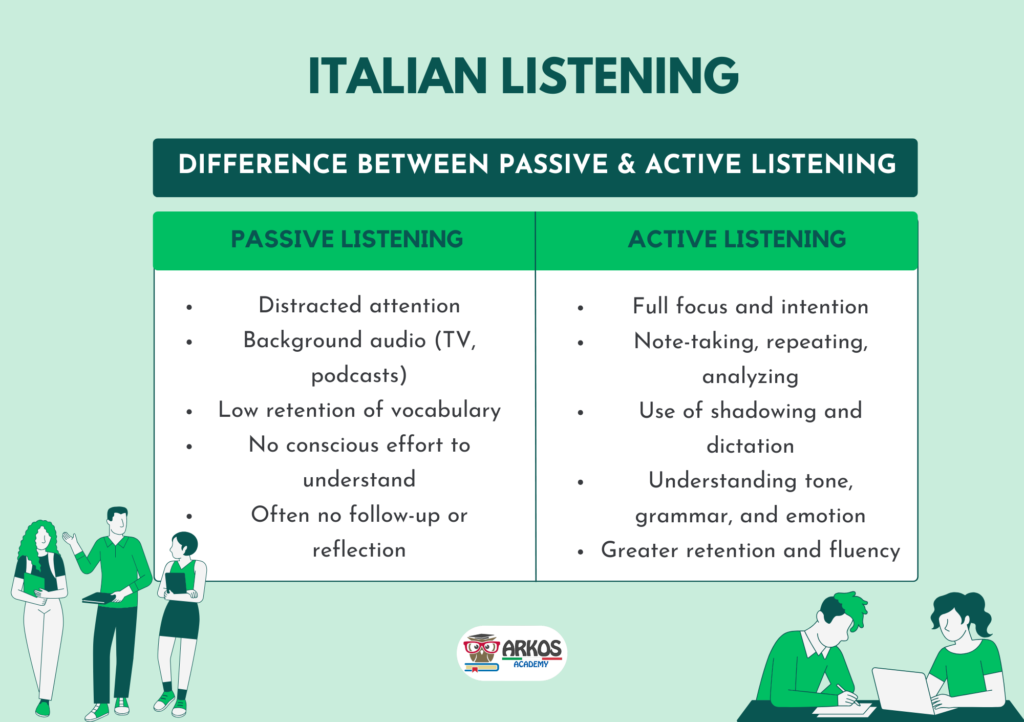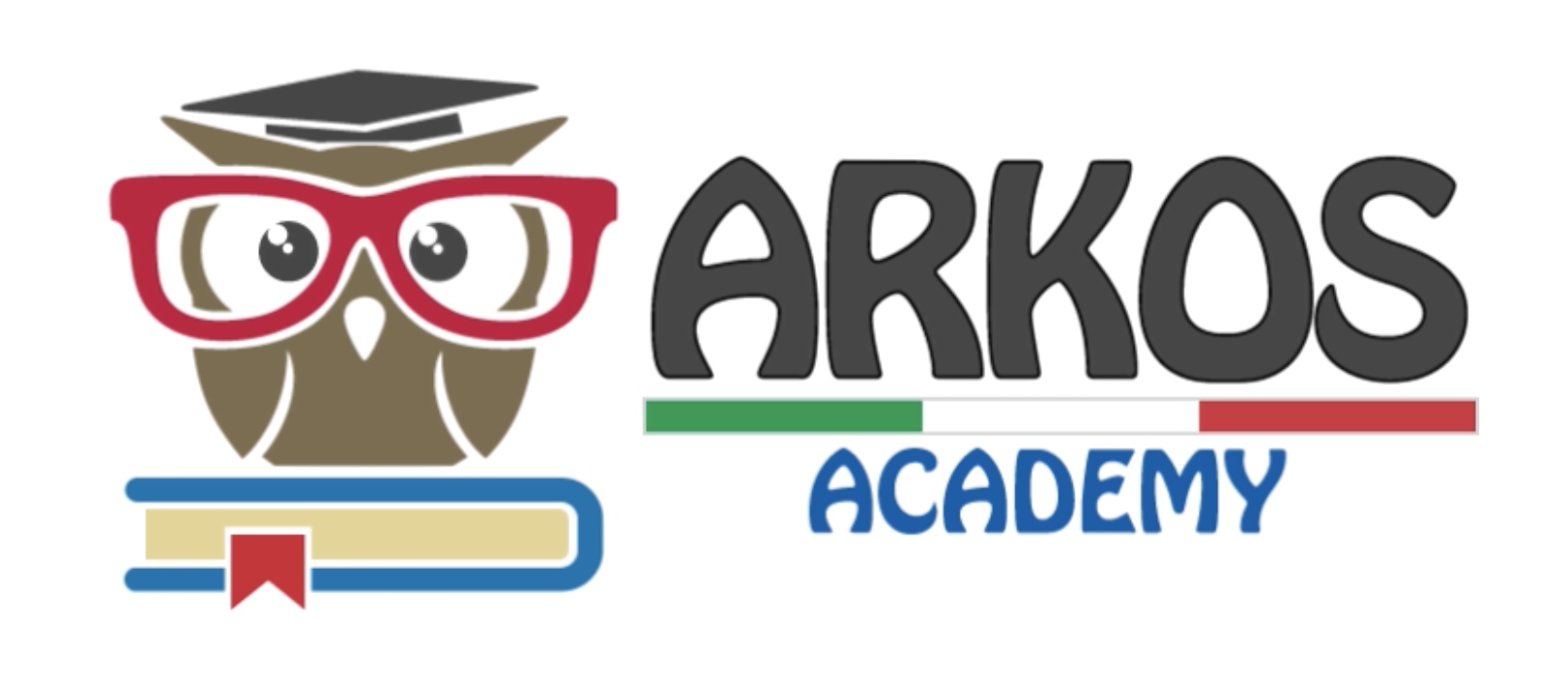How to Improve Your Skills with Active and Engaging Techniques
Why Listening in Italian is Key to Learning the Language
Listening is one of the most powerful tools in language learning. If you’re trying to improve your Italian, building your listening skills should be a top priority. Listening in Italian helps you get used to the sound, rhythm, and natural flow of the language. But there’s more: active listening — listening with intention and focus — can completely change how fast and how well you learn. In this article, you’ll discover the difference between passive and active listening, practical techniques to improve your Italian listening comprehension, and easy ways to practice every day — even with just a few minutes.
What Does Active Listening Mean When Learning Italian?
Active listening is different from just hearing the language in the background. It means paying full attention — to the speaker’s tone, the context, and the emotions behind the words. Unlike passive listening, which might happen while watching TV without subtitles or playing a podcast while distracted, active listening pushes you to understand, reflect, and imitate. It’s one of the fastest ways to improve both comprehension and speaking confidence.
Passive vs. Active Listening: What’s the Difference?
Think of passive listening like looking out a train window: the view goes by, but you don’t stop to notice much. That’s how many people experience Italian when they watch a movie without really trying to understand.
Active listening, instead, is like walking through that landscape, noticing details, asking questions, and engaging with the environment. You become more aware of how sentences are built, how words are pronounced, and what emotions are being expressed.

Why Listening in Italian Helps You Improve Faster
Listening in Italian every day — and doing it actively — helps you:
- Get used to the melody and rhythm of the language
- Understand grammar structures without memorizing rules
- Pick up new vocabulary naturally
- Feel more confident when speaking
It also improves your cultural understanding. Italian is full of idiomatic expressions, gestures, and intonation. The more you hear, the more you feel the language. For authentic Italian media that reflects the culture and language in action, check out RAI Cultura.
Easy Strategies to Practice Listening in Italian
Many learners think they need to be living in Italy or have a language partner to practice listening effectively. While that helps, it’s far from necessary. What matters most is consistency — and building smart habits around the Italian you hear every day.
- Immerse yourself: Surround yourself with Italian every day. Watch YouTube videos, listen to podcasts, follow Italian creators on social media.
- Short daily practice: Even 10–15 minutes a day makes a difference. Keep it consistent.
- Pick your favorite topics: Interested in cooking? Art? Travel? Find content that matches your passions.
- Talk to native speakers: Use platforms or local meetups to have real conversations — the best kind of practice!
These small actions create the foundation for the more structured exercises we’ll explore next — but remember, consistency is what turns strategies into skills. Don’t wait for the “perfect moment” or the “perfect resource.” Start small, stay curious, and let your ears guide you.
Practical Exercises to Improve Italian Listening Comprehension
Sometimes strategies alone aren’t enough — you need real, repeatable actions to train your ears and brain to understand spoken Italian. The exercises below are tried and tested by language learners worldwide, and they work especially well when practiced regularly. Each one can be adapted to your level and learning style. Try them out, mix them, and see what works best for you.
Shadowing
This technique involves listening to a short sentence or phrase and repeating it immediately, trying to match the speaker’s intonation, rhythm, and emotion. It’s like singing along with a song — but in a focused way.
Use it with: podcast clips, short video dialogues, or lines from your favorite movie. You can try it with our YouTube videos where Italian is spoken clearly and slowly.
Tip: Start with subtitles, then remove them gradually as your confidence grows.
Dictation
Take a short audio (30–60 seconds), play it sentence by sentence, and write down what you hear. This sharpens both your listening precision and your spelling.
Use it with: news clips, learner-friendly audio, or your teacher’s voice notes. A great option is our free podcast section with transcripts — you can listen, pause, and write as a dictation exercise.
Tip: Don’t worry if you miss a few words — repeat, pause, and check the transcript after.
Dialogue Breakdown
Listen to a conversation between native speakers. Then, analyze how they structure their speech: look for idioms, sentence patterns, filler words, and emotional tone.
Use it with: podcasts with transcripts or subtitled YouTube videos.
Next step: Repeat each line out loud — not just to memorize it, but to internalize the flow of real Italian speech.
📼 Bonus: Combine with visual cues
If you’re a visual learner, pair your audio with video or gestures. Watching facial expressions, body language, and lip movement adds an extra layer of comprehension.
Try: TV series, interviews, or educational YouTube content.
The Benefits of Listening Practice in Italian
When learners commit to consistent listening, especially with active strategies, the results go far beyond just understanding more words. Listening is the secret ingredient that connects everything: vocabulary, pronunciation, grammar, culture — even confidence.
Better comprehension in real-life situations
Listening helps you recognize language in its most natural form: fast, emotional, and full of nuance. This means that when you hear Italians speak on the street, in a movie, or during a lesson, you’ll understand more than just isolated words — you’ll grasp the meaning, tone, and intention behind what’s being said.
More natural pronunciation
By tuning in to native speakers, your ears begin to “train” your mouth. You’ll subconsciously absorb how certain letter combinations are pronounced, where to place stress, and how intonation rises and falls in a natural Italian sentence. This makes your spoken Italian more fluid and less robotic — even before you actively practice speaking.
Increased vocabulary and grammar awareness
Listening allows you to encounter grammar in context, rather than as isolated rules. You’ll hear how tenses work in real speech, how prepositions are used, or how certain idiomatic phrases pop up again and again. It’s grammar without the textbook headache — and vocabulary that sticks because it has meaning.
Deeper cultural understanding
The Italian language is tightly connected to Italian culture: humor, irony, formality, gestures. By listening regularly, you begin to pick up on all the things that aren’t always written in a dictionary. You start to understand what makes Italian… Italian.
Common Obstacles and How to Overcome Them
Even the most motivated learners encounter challenges when practicing listening in Italian. It’s perfectly normal to feel stuck, frustrated, or overwhelmed at times. Recognizing these obstacles — and knowing how to respond — can make a big difference in your progress.
- Distractions: Choose a quiet space and use headphones.
- Fear of not understanding: It’s okay not to get everything! Focus on keywords and context.
- Fast speech: Start with slower content or adjust playback speed.
Overcoming these issues isn’t about being perfect — it’s about being consistent, kind to yourself, and smart with your practice. With a bit of patience and the right mindset, each obstacle becomes another opportunity to grow.
Frequently Asked Questions
1. What’s the best way to start listening in Italian if I’m a beginner?
Start with slow and clear content designed for learners. You can try our free podcast episodes with transcripts or visit our YouTube channel for videos spoken at a moderate pace.
2. Can I really improve my Italian just by listening?
Absolutely — but it depends on how you listen. Passive listening helps with exposure, but active listening is where real progress happens. Combine listening with repetition, shadowing, and note-taking to improve much faster.
3. What type of audio is best for practicing listening in Italian?
It depends on your level. Beginners benefit from short dialogues or songs with lyrics. More advanced learners can try Italian movies or news reports. We also recommend our Italian song course for guided listening practice with cultural context.
4. How can I improve my Italian pronunciation through listening?
Listening is the first step. But to really master pronunciation, you need to repeat what you hear. Our Italian alphabet and pronunciation course is a great place to start if you want to fine-tune your sounds.
Conclusion: Make Listening in Italian Part of Your Daily Life
You don’t need to move to Italy to improve your Italian listening comprehension. With the right strategies and consistency, you can make big progress from anywhere. Start small, be curious, and make listening a fun habit.
➡️ Want more? Check out our Italian song course or downloadable audio eBooks for immersive listening practice.
Explore More Ways to Improve Your Italian
Here are some of our most helpful resources to take your Italian listening — and speaking — to the next level:
- 🎵 Learn with Music – Learning Italian with Songs: Common Pronunciation Mistakes
- 🎬 Watch & Learn – Improve Your Italian with Movies
- 🔤 Master Your Pronunciation – Italian Alphabet and Pronunciation Course
- 🌍 Understand Regional Nuances – Italian Accents and Dialects Explained
- 🎧 Practice with Podcasts – Free Italian Podcasts with Transcripts
- 📺 Slow Italian Listening – Watch on YouTube
- 👥 Private Lessons – Book a private Italian lesson for personalized help




